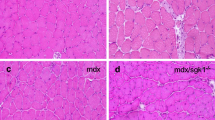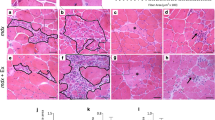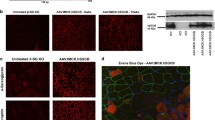Abstract
Duchenne muscular dystrophy (DMD) is a genetic disorder in which muscle weakness and fragility contribute to ongoing muscle degeneration. Although exercise-induced muscle damage is associated with adaptation that protects normal muscle from further damage, exploiting this process to protect dystrophic muscle has been avoided for fear of inducing excessive muscle degeneration. However, muscle-specific over-expression of the class 1:Ea isoform of insulin-like growth factor-1 (IGF-1) reduces myofibre necrosis in dystrophic mdx mice (a model for DMD) and, therefore, may enhance the adaptation process in response to eccentric exercise. To test this hypothesis, we evaluated the effect of transgenic class 1:Ea IGF-1 over-expression on the susceptibility to muscle damage and subsequent adaptation in 12-week-old dystrophic mdx and non-dystrophic control mice. Experiments were conducted in vivo using a custom-built isokinetic mouse dynamometer to measure the deficit in joint torque (indicating muscle damage) after 20 maximal lengthening (eccentric) contractions. Adaptation to this damaging exercise was evaluated by repeating the protocol 7 days after the initial exercise. The over-expression of IGF-1 significantly increased the normalised joint torque in non-dystrophic mice and appeared to ameliorate the muscle weakness in dystrophic mice. All mice displayed a marked reduction in the susceptibility to muscle damage on day 7; however, this adaptation was unaffected by IGF-1, showing that IGF-1 does not protect the dystrophic muscles of adult mdx mice against damage resulting from maximal lengthening contractions.








Similar content being viewed by others
References
Angelini C (2007) The role of corticosteroids in muscular dystrophy: a critical appraisal. Muscle Nerve 36:424–435
Ansved T (2003) Muscular dystrophies: influence of physical conditioning on the disease evolution. Curr Opin Clin Nutr Metab Care 6:435–439
Ashton-Miller JA, He Y, Kadhiresan VA et al (1992) An apparatus to measure in vivo biomechanical behavior of dorsi- and plantarflexors of mouse ankle. J Appl Physiol 72:1205–1211
Barton ER, Morris L, Musaro A et al (2002) Muscle-specific expression of insulin-like growth factor I counters muscle decline in mdx mice. J Cell Biol 157:137–148
Brooks SV (1998) Rapid recovery following contraction-induced injury to in situ skeletal muscles in mdx mice. J Muscle Res Cell Motil 19:179–187
Broussard SR, McCusker RH, Novakofski JE et al (2003) Cytokine-hormone interactions: Tumor necrosis factor (alpha) impairs biologic activity and downstream activation signals of the insulin-like growth factor I receptor in myoblasts. Endocrinology 144:2988–2996
Call JA, Voelker KA, Wolff AV et al (2008) Endurance capacity in maturing mdx mice is markedly enhanced by combined voluntary wheel running and green tea extract. J Appl Physiol. doi:10.1152/japplphysiol.00028.2008
Carter GT, Wineinger MA, Walsh SA et al (1995) Effect of voluntary wheel-running exercise on muscles of the mdx mouse. Neuromuscul Disord 5:323–332
Childers MK, Okamura CS, Bogan DJ et al (2002) Eccentric contraction injury in dystrophic canine muscle. Arch Phys Med Rehabil 83:1572–1578
De Luca A, Pierno S, Liantonio A et al (2003) Enhanced dystrophic progression in mdx mice by exercise and beneficial effects of taurine and insulin-like growth factor-1. J Pharmacol Exp Ther 304:453–463
Dupont-Versteegden EE, McCarter RJ, Katz MS (1994) Voluntary exercise decreases progression of muscular dystrophy in diaphragm of mdx mice. J Appl Physiol 77:1736–1741
Fraysse B, Liantonio A, Cetrone M et al (2004) The alteration of calcium homeostasis in adult dystrophic mdx muscle fibers is worsened by a chronic exercise in vivo. Neurobiol Dis 17:144–154
Friden J, Lieber RL (2001) Serum creatine kinase level is a poor predictor of muscle function after injury. Scand J Med Sci Sports 11:126–127
Frost RA, Nystrom GJ, Lang CH (2003) Tumor necrosis factor-alpha decreases insulin-like growth factor-I messenger ribonucleic acid expression in C2C12 myoblasts via a jun N-terminal kinase pathway. Endocrinology 144:1770–1779
Gehrig SM, Ryall JG, Schertzer JD et al (2008) IGF-I analogue protects muscles of dystrophic mdx mice from contraction-mediated damage. Exp Physiol. doi:10.1113/expphysiol.2008.042838
Gleeson N, Eston R, Marginson V et al (2003) Effects of prior concentric training on eccentric exercise induced muscle damage. Br J Sports Med 37:119–125
Gosselin LE, Burton H (2002) Impact of initial muscle length on force deficit following lengthening contractions in mammalian skeletal muscle. Muscle Nerve 25:822–827
Grange RW, Call JA (2007) Recommendations to define exercise prescription for Duchenne muscular dystrophy. Exerc Sport Sci Rev 35:12–17
Gregorevic P, Plant DR, Lynch GS (2004) Administration of insulin-like growth factor-I improves fatigue resistance of skeletal muscles from dystrophic mdx mice. Muscle Nerve 30:295–304
Gregory J, Morgan D, Allen T et al (2007) The shift in muscle’s length–tension relation after exercise attributed to increased series compliance. Eur J Appl Physiol 99:431–441
Grounds MD, Radley HG, Gebski BL et al (2008) Implications of cross-talk between TNF and IGF-1 signalling in skeletal muscle. Clin Exp Pharmacol Physiol 35:846–851
Grounds MD, Radley HG, Lynch GS et al (2008) Towards developing standard operating procedures for pre-clinical testing in the mdx mouse model of Duchenne muscular dystrophy. Neurobiol Dis 31:1–19
Grounds MD, Sorokin L, White J (2005) Strength at the extracellular matrix–muscle interface. Scand J Med Sci Sports 15:381–391
Hamer PW, McGeachie JM, Davies MJ et al (2002) Evans blue dye as an in vivo marker of myofibre damage: optimising parameters for detecting initial myofibre membrane permeability. J Anat 200:69–79
Hayes A, Lynch GS, Williams DA (1993) The effects of endurance exercise on dystrophic mdx mice. I. Contractile and histochemical properties of intact muscles. Proc R Soc Lond B Biol Sci 253:19–25
Hodgetts S, Radley H, Davies M et al (2006) Reduced necrosis of dystrophic muscle by depletion of host neutrophils, or blocking TNF[alpha] function with Etanercept in mdx mice. Neuromuscul Disord 16:591–602
Kilmer DD, Aitkens SG, Wright NC et al (2001) Response to high-intensity eccentric muscle contractions in persons with myopathic disease. Muscle Nerve 24:1181–1187
Kornegay JN, Bogan DJ, Bogan JR et al (1999) Contraction force generated by tarsal joint flexion and extension in dogs with golden retriever muscular dystrophy. J Neurol Sci 166:115–121
Lynn R, Morgan DL (1994) Decline running produces more sarcomeres in rat vastus intermedius muscle fibers than does incline running. J Appl Physiol 77:1439–1444
McGeachie JK, Grounds MD, Partridge TA et al (1993) Age-related changes in replication of myogenic cells in mdx mice: quantitative autoradiographic studies. J Neurol Sci 119:169–179
McHugh MP (2003) Recent advances in the understanding of the repeated bout effect: the protective effect against muscle damage from a single bout of eccentric exercise. Scand J Med Sci Sports 13:88–97
Morgan DL (1990) New insights into the behavior of muscle during active lengthening. Biophys J 57:209–221
Musaro A, McCullagh K, Paul A et al (2001) Localized Igf-1 transgene expression sustains hypertrophy and regeneration in senescent skeletal muscle. Nat Genet 27:195–200
Okano T, Yoshida K, Nakamura A et al (2005) Chronic exercise accelerates the degeneration-regeneration cycle and downregulates insulin-like growth factor-1 in muscle of mdx mice. Muscle Nerve 32:191–199
Proske U, Morgan DL (2001) Muscle damage from eccentric exercise: mechanism, mechanical signs, adaptation and clinical applications. J Physiol (Lond) 537:333–345
Radley HG, Davies MJ, Grounds MD (2008) Reduced muscle necrosis and long-term benefits in dystrophic mdx mice after cV1q (blockade of TNF) treatment. Neuromuscul Disord 18:227–238
Schertzer JD, van der Poel C, Shavlakadze T et al (2008) Muscle-specific overexpression of IGF-I improves E–C coupling in skeletal muscle fibers from dystrophic mdx mice. Am J Physiol Cell Physiol 294:C161–168
Shavlakadze T, Boswell JM, Burt DW et al (2006) Rsk[alpha]-actin/hIGF-1 transgenic mice with increased IGF-I in skeletal muscle and blood: impact on regeneration, denervation and muscular dystrophy. Growth Horm IGF Res 16:157–173
Shavlakadze T, White J, Hoh JFY et al (2004) Targeted expression of insulin-like growth factor-1 reduces early myofiber necrosis in dystrophic mdx mice. Mol Ther 10:829–843
Shavlakadze T, White JD, Davies M et al (2005) Insulin-like growth factor I slows the rate of denervation induced skeletal muscle atrophy. Neuromuscular Disord 15:139–146
Shavlakadze T, Winn N, Rosenthal N et al (2005) Reconciling data from transgenic mice that overexpress IGF-I specifically in skeletal muscle. Growth Horm IGF Res 15:4–18
Sveen M-L, Jeppesen TD, Hauerslev A et al (2007) Endurance training: an effective and safe treatment for patients with LGMD2I. Neurology 68:59–61
Tidball JG (2005) Mechanical signal transduction in skeletal muscle growth and adaptation. J Appl Physiol 98:1900–1908
Warren GL, Hulderman T, Jensen N et al (2002) Physiological role of tumor necrosis factor a in traumatic muscle injury. FASEB J 16:1630–1632
Whitehead NP, Yeung EW, Allen DG (2006) Muscle damage in mdx (dystrophic) mice: role of calcium and reactive oxygen species. Clin Exp Pharmacol Physiol 33:657–662
Wineinger MA, Abresch RT, Walsh SA et al (1998) Effects of aging and voluntary exercise on the function of dystrophic muscle from mdx mice. Am J Phys Med Rehab 77:20–27
Acknowledgements
We gratefully acknowledge the assistance of Thea Shavlakadze and Marilyn Davies with the supply of the transgenic class 1:Ea mdx/IGF-1 mice. We sincerely thank Hannah Radley and Thea Shavlakadze for the critical reading of the manuscript and Adam Piers for the assistance with the EBD experiments. Construction of the mouse dynamometer was partially supported from a grant to PH from the Physiotherapy Research Foundation (Australia).
Author information
Authors and Affiliations
Corresponding author
Rights and permissions
About this article
Cite this article
Ridgley, J.A., Pinniger, G.J., Hamer, P.W. et al. The physiological effects of IGF-1 (class 1:Ea transgene) over-expression on exercise-induced damage and adaptation in dystrophic muscles of mdx mice. Pflugers Arch - Eur J Physiol 457, 1121–1132 (2009). https://doi.org/10.1007/s00424-008-0568-4
Received:
Revised:
Accepted:
Published:
Issue Date:
DOI: https://doi.org/10.1007/s00424-008-0568-4




